Hydrogeological situation on 1 August 2023
In July, the depletion continued for all aquifers and the levels of most of them (89%), were decreasing. Rainfall at the end of July, over the northern third of the country, had a limited impact, and only on highly reactive aquifers.
The general situation continued to deteriorate slowly. The situation remains unsatisfactory across much of the country: seventy-two percent of aquifer levels remained below monthly averages in July (as opposed to 68% at the end of June 2023).
In July and until the end of summer, aquifer levels are expected to continue falling. The situation of inertial aquifers is not expected to change much in the next few weeks, except in areas with particularly high demand for groundwater abstraction. As regards the reactive aquifers, the trends and developments will depend primarily on effective local rainfall, the degree of evapotranspiration and the demand for water. Recharge episodes are expected to be occasional, and of low intensity. The situation will need to be closely monitored in aquifers which currently have levels that are below the monthly norms, as well as in areas where abstraction demand is particularly high.
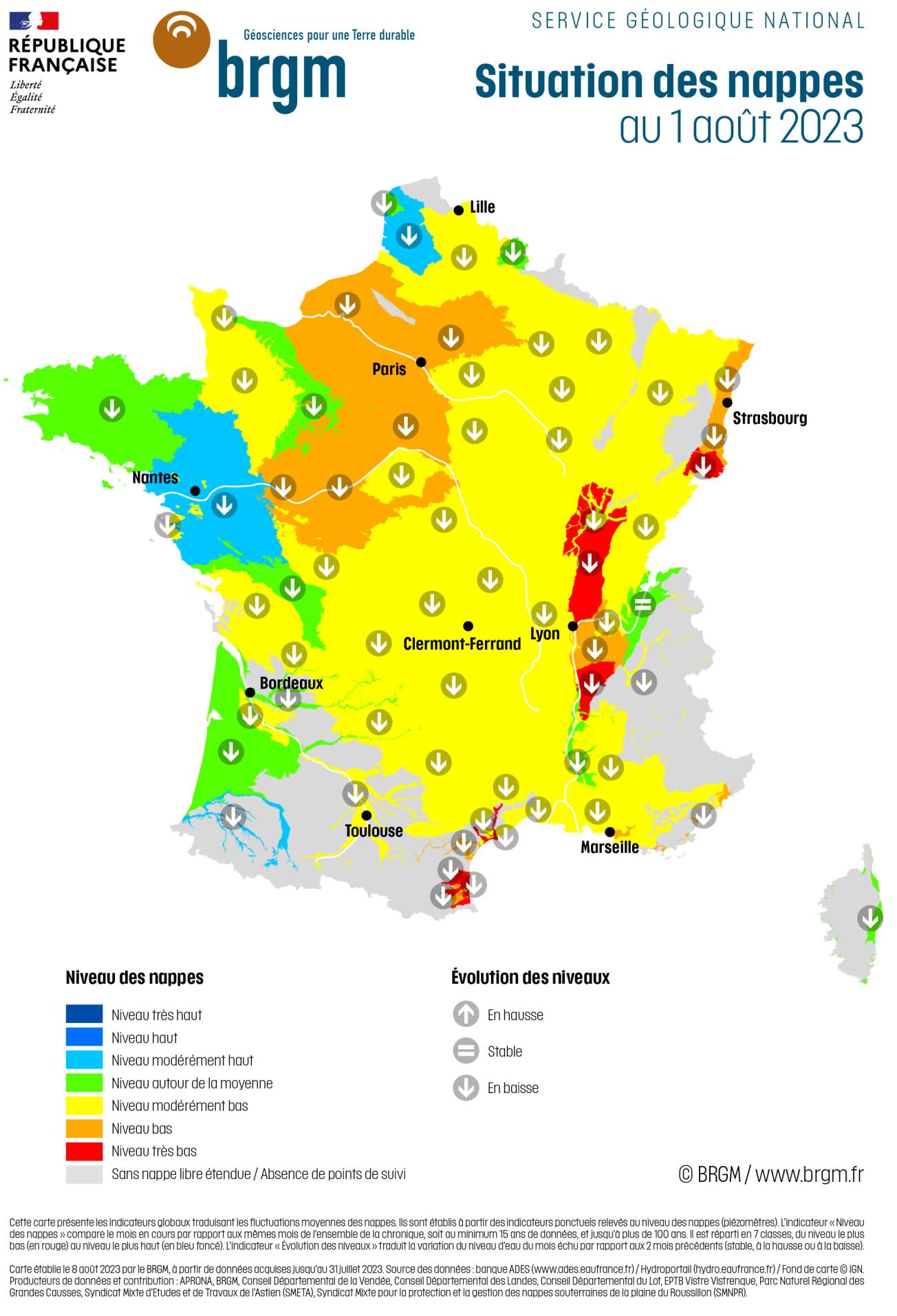
Map of aquifer levels in mainland France on 1 August 2023.
© BRGM
Groundwater trends
The 2022-2023 recharge period was deficient over a large part of France. Early spring rainfall led to recharge episodes, thus delaying the start of the depletion period in those areas with the highest rainfall. The depletion period began gradually between March and May. In June, rainfall added little to the aquifers. It only sustained the levels of reactive aquifers located in areas that received a lot of rain.
In July, all of the aquifers were being depleted: levels were found to have dropped at 89% of the observation points (75% in June). The rainfall in May and June in the south and in July in the north helped to sustain water levels in those areas with reactive aquifers and to limit demand on groundwater resources.
Depletion continued or resumed in July over the southern two-thirds of France. This was not surprising given that there was practically no rainfall in July in this part of the country. The impact of infiltration following the rains of May and June lessened and the aquifers were again depleting. The speed of depletion depends essentially on the volumes abstracted.
Rainfall in the northern third of France added little to the aquifers. This is because rainfall from sometimes violent storms tends to run off and only percolates a little into the ground. What's more, the rainfall initially helped to moisten the soil and was taken up by vegetation. The lack of recharge can also be explained by contrasting rainfall patterns over time and space. However, this rainfall means that irrigation can be reduced to a greater or lesser extent, thereby easing the pressure on groundwater resources.
The levels of the reactive aquifers in the northern third of the country fell during July. We will probably have to wait until mid-August to determine whether the rains of late July and early August have had an impact. However, levels were able to stabilise or even rise slightly at the end of July in the areas which had the most rainfall. For instance, a slight recharge at the end of the month was observed for the Armorican Massif basement aquifers (from Brittany to northern Vendée).
As regards the inertial water tables in the Paris and Artois basins, the rainfall is expected to have little or no impact over the coming weeks and will not reverse the downward trend. It can take as long as 3 months for rainfall to infiltrate into the most inertial aquifers.
The situation in relation to July averages
In 2022, the low-water period was severe for most of the aquifers, with recharging remaining low during the autumn and winter of 2022-2023. At the end of the winter, the condition of the aquifers was therefore unsatisfactory. Rainfall in the spring and early summer helped to improve the condition of the most reactive aquifers in the northern two-thirds of the country in April and in the southern third in June.
Between April and July, there was little change in the overall groundwater situation across the country, and it even deteriorated slightly between June and July. Overall, the state of the aquifers remained unsatisfactory in July: the levels at 10% of the observation points were above monthly norms (13% in June), but 72% of the levels remained moderately low to very low (68% in June) while 20% were very low (19% in June). The situation is similar to that of last year (73% of levels below normal in July 2022) but with local variability.
For the reactive aquifers, the situation generally remained stable between June and July. It is slowly deteriorating in areas where there is a shortage of rainfall and in those aquifers that are the most sensitive to the lack of recharge.
The rainfall accumulated over the spring enabled the reactive aquifers in the north (Boulonnais and Avesnois) and from Brittany to the south-west to remain at levels close to or above their monthly norms.
From the Massif Central to the Grand-Est, reactive aquifer levels are moderately low, and even low on the Alsace alluvial plain. However, situations can vary greatly locally, depending on local rainfall totals over the last few weeks. Rainfall in July, combined with low temperatures, helped to sustain water levels, ease the pressure on water resources and maintain aquifer levels.
Around the Mediterranean, the situation of the aquifers is heterogeneous, depending on the total amount of rainfall and the intensity of pumping. There was sometimes enough rainfall in May and June to generate recharge and improve the state of the aquifers in June. However, the scarce rainfall in July led to a deterioration of their condition. Levels varied locally but generally remained close to normal for Corsica and the lower Rhône and moderately low for Provence and the Montpellier and Nîmes regions. They were low to very low on the coastal aquifers of the Côte d'Azur, and in the Hérault and the Orb, the Aude and Roussillon rivers. The risk of sea water intrusion increased in coastal areas which had low to very low water levels, from the Côte d'Azur to Roussillon.
As for the inertial aquifers, the rain over the last few weeks has had no effect and their condition is gradually deteriorating. This is normal, as they are not very sensitive to meteorological events during the summer. Only the chalk aquifers of the Channel coast benefited from a significantly excessive winter recharge in 2022-2023 and have high levels. The state of the inertial aquifers in the Artois and Paris Basins is not very favourable, with levels being moderately low to low. The situation may be more strained locally, with very low levels. Aquifer levels in the Sundgau aquifers (southern Alsace) and those in the Rhône-Saône corridor are a cause for concern, ranging from moderately low to very low. Many sectors are recording record lows.
Aquifers that are in good condition
Several aquifers were found to be in good condition, with levels ranging from moderately high to high in relation to the levels recorded for July in previous years:
- The levels of the Cenomanian chalk marl aquifer on the Artois-Picardy coast are moderately high, following the high excess recharge of 2022-2023;
- The aquifers of the Armorican Massif basement, from eastern Brittany to the Vendée, were recharged during the spring and at the end of July and their levels are moderately high;
- Levels in the Adour and Gave de Pau alluvial aquifers are moderately high, thanks to excess rainfall in May and June.
Aquifers that are in poor condition
Many aquifers are in poor condition with very low levels compared to July levels for previous years, owing to an extreme rainfall deficit these last few months or years:
- The inertial Plioquaternary and Miocene aquifers in the Sundgau, Dijonnais, Bresse, Dombes, Nord Isère and Bas-Dauphiné areas have low to very low levels, due to several successive winter recharges of low intensity and to their very inertial behaviour;
- The Hérault and Orb alluvial aquifers had very low levels, with the rainfall in June unable to compensate for the deficits recorded since 2022;
- The aquifers of the Roussillon multi-layer aquifer are in an unprecedented situation, with low to very low levels. Rainfall and restrictions on abstraction seem to be having a beneficial effect, but it is often localised and very insufficient to compensate for the deficits accumulated since 2022.
Comparison between 1 August 2022 and 1 August 2023
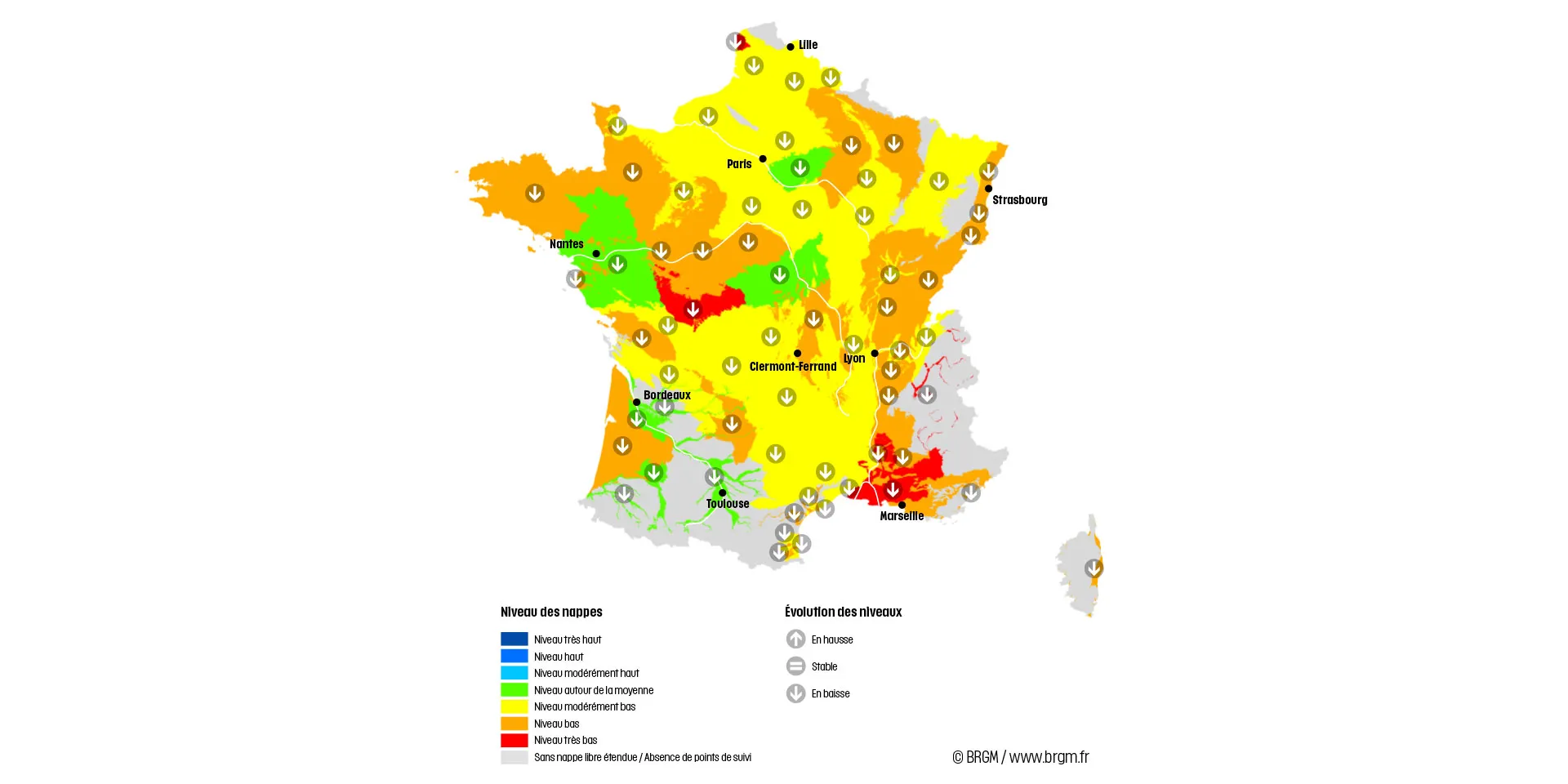
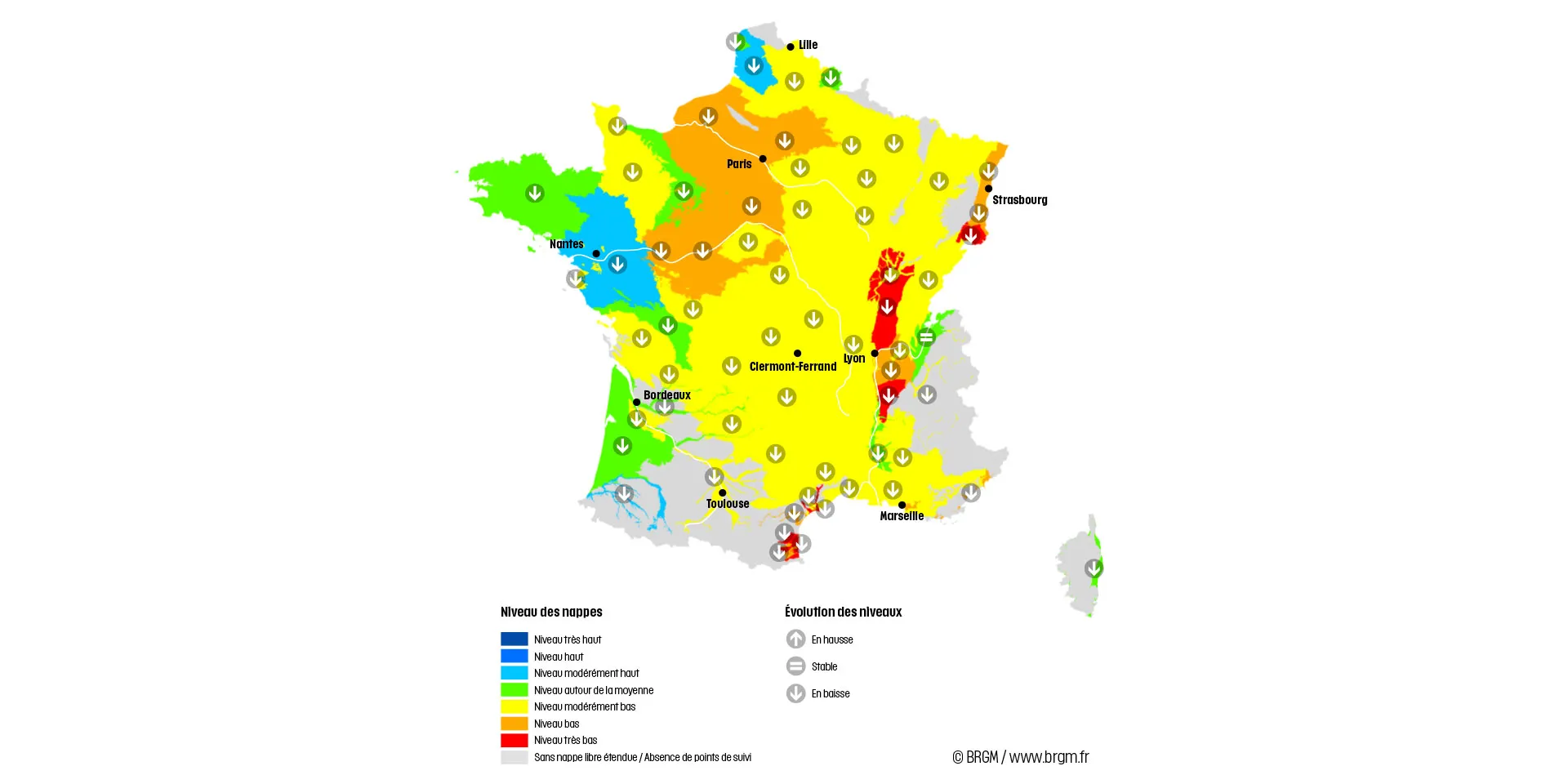
Map of France showing the state of the aquifers on 1 August 2022 (left) and 1 August 2023 (right).
© BRGM
Forecasts
The seasonal forecasts from Météo-France for August, September and October predict higher-than-normal temperatures across the country and wetter-than-normal conditions in the southernmost part of the country, from the Pyrenees to the Mediterranean basin. Elsewhere, no clear scenario has emerged for rainfall.
The conditions for the likelihood of recording a recharge episode and observing a possible improvement in the groundwater situation are: light but sustained rainfall that is well distributed both spatially and over time, damp soils, low demand for water from plants (low temperatures or vegetation that is not very active) and aquifers that are sensitive to meteorological events. Active vegetation and thus increased evapotranspiration usually limit the infiltration of rainfall into aquifers during summer. The high temperatures, predicted by Météo-France, are increasing the water requirements of vegetation and water abstraction.
As regards reactive aquifers, the trends and developments will depend primarily on effective local rainfall and the demand for water. However, the infiltration of rainfall at depth is likely to remain very limited, and depletion should continue until the autumn and the arrival of significant rainfall. The situation is likely to deteriorate rapidly for aquifers that do not benefit from small recharge events and for those that are most affected by abstraction.
In the northern third of the country, heavy rainfall totals at the end of July and beginning of August could lead to recharging of reactive aquifers. These inputs could help to maintain or even improve the condition of the aquifers. This improvement will only last if there is sufficient rain that continues in August. If this is not the case, depletion should resume quickly after the rain stops and the situation should remain stable or deteriorate.
For the southern two-thirds of the country, the depletion should theoretically continue and the levels should continue dropping for the next few weeks. However, significant rainfall events could lead to brief recharging. This would help sustain aquifer levels and possibly even lead to increases. However, these recharge episodes will be limited by dry soils, active vegetation and stormy rainfall events.
As regards the inertial aquifers of the Artois Basin, the Paris Basin, the Sundgau (southern Alsace) and the Rhône-Saône corridor, no recharge episodes are expected during the summer, barring very exceptional rainfall events. No improvement is expected until the autumn, when vegetation goes dormant and the rains return. The situation is expected to gradually deteriorate, more or less slowly, depending on the volumes of groundwater abstracted. In the Artois and Paris basins, the excess rainfall in July should limit irrigation needs and thus ease the pressure on water resources. The effective rainfall could infiltrate slowly at depth and attenuate the discharge over the coming weeks. However, the impact of these inputs is likely to be limited and will not improve the state of the aquifers.
The situation will need to be closely monitored in aquifers which currently have levels that are below the July norms, as well as in areas where abstraction demand is particularly high.
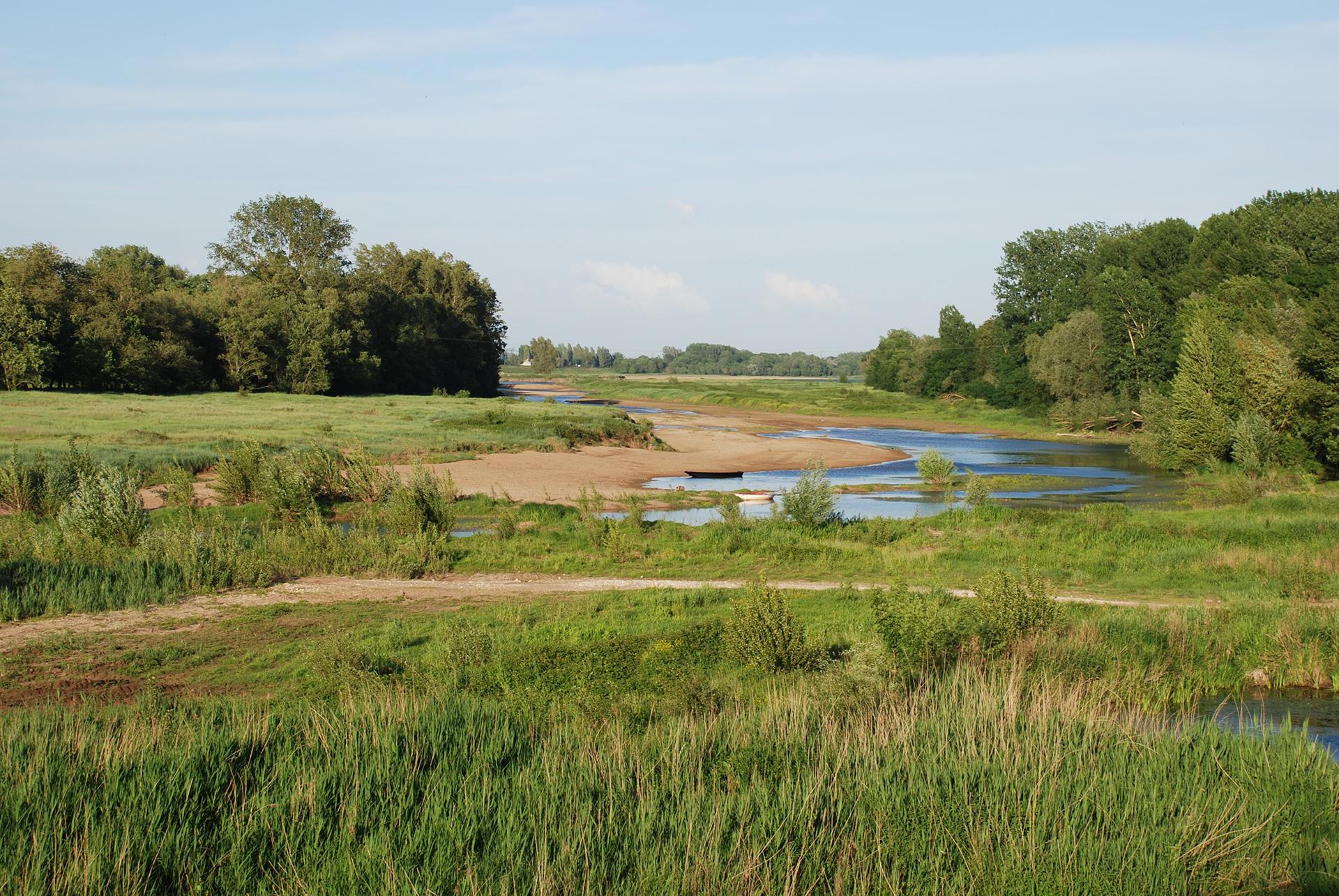
State of groundwater: monitoring by BRGM
Groundwater is a widely used resource: in metropolitan France, it accounts for nearly two-thirds of drinking water consumption and more than one-third of agricultural water consumption. It is also widely used in the industrial sector. Groundwater tables depend on cyclical recharges.
BRGM monitors groundwater levels and quality in mainland France. Discover the actions carried out by the French geological survey and the resources and databases available on groundwater in France.
Press contact


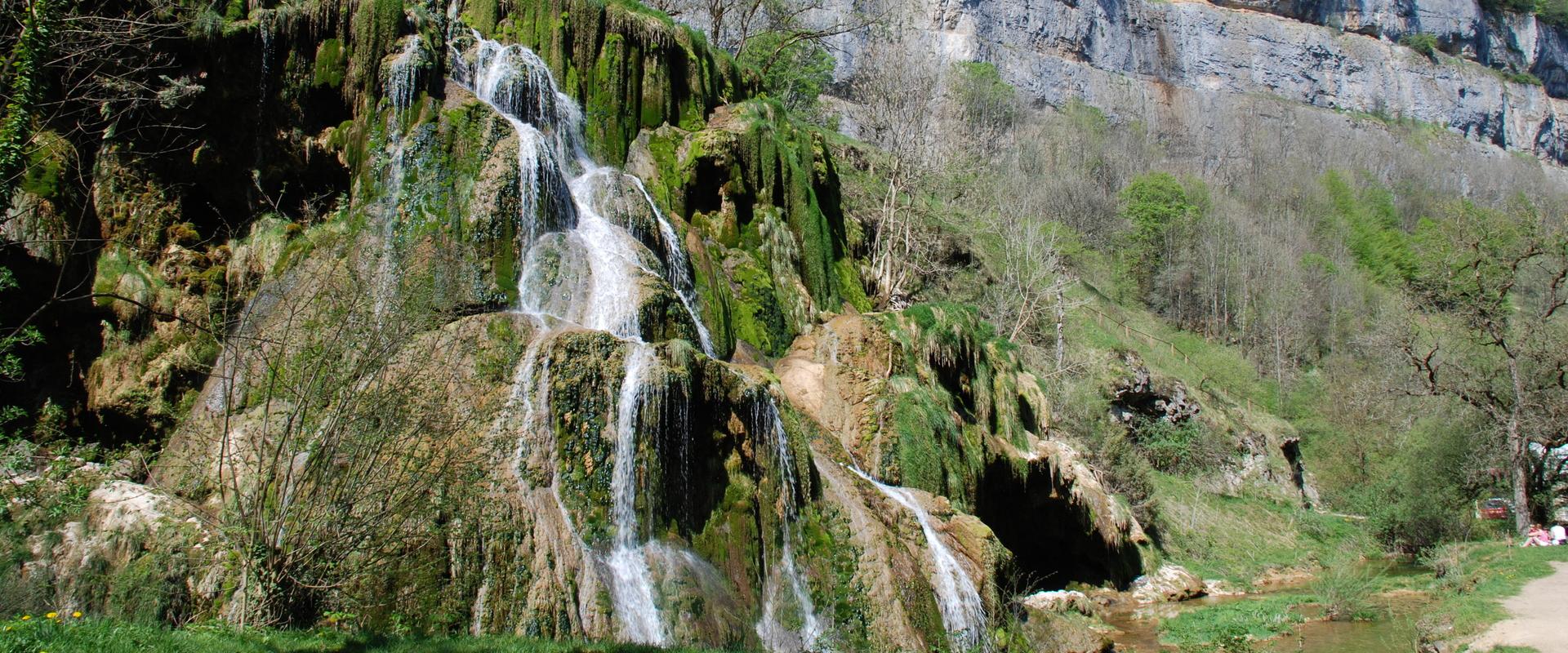
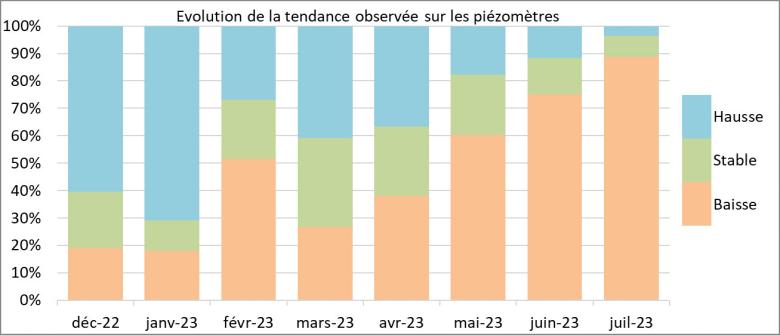
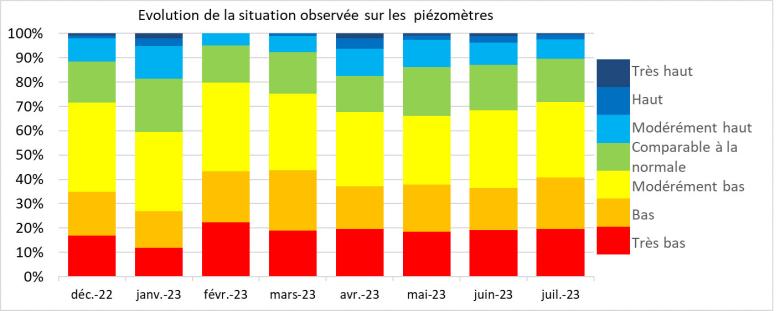






Map drawn up by BRGM on 8 August 2023, based on data from the ADES database, acquired up to 31 July 2023. Data source: ADES database (ades.eaufrance.fr) / Hydroportail (hydro.eaufrance.fr) / Background map © IGN. Data producers and contributors: APRONA, BRGM, Conseil Départemental de la Vendée, Conseil Départemental des Landes, Conseil Départemental du Lot, EPTB Vistre Vistrenque, Parc Naturel Régional des Grandes Causses, Syndicat Mixte d'Etudes et de Travaux de l'Astien (SMETA), Syndicat Mixte pour la protection et la gestion des nappes souterraines de la plaine du Roussillon (SMNPR).
This map shows the global indicators reflecting the average fluctuations of the aquifers. They are based on point indicators collected at groundwater monitoring points (by means of piezometers).
The "Aquifer levels" indicator compares the current month’s figures with those of the same months in the entire record, i.e. at least 15 years of data and sometimes up to as much as 100 years of data. It is divided into 7 classes, from the lowest level (in red) to the highest (in dark blue).
The grey areas correspond to areas without unconfined aquifers, i.e. with an impermeable or semi-permeable layer above the aquifer, and/or sectors with a very low density of measuring points. This last case primarily concerns mountainous areas with small, heterogeneous aquifers.
The "Evolution of levels" indicator reflects the variation of the water level of the past month compared to the two previous months (stable, increasing or decreasing).
These global indicators reflect general situations and trends and do not take into account possible local disparities.